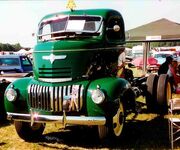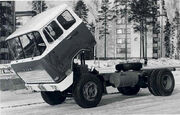Cab-over, also known as Cab Over Engine (COE), cab forward (U.S. English), or forward control (British English), is a body style of truck, bus, or van that has a vertical front or "flat face", with the cab of the truck sitting above the front axle, this contrasts with a conventional-cab truck where the engine is mounted in front of the driver.
This truck configuration is currently common among European and Japanese truck manufacturers, because the laws governing overall vehicle lengths are strict and the body style allows longer trailers (in the case of a tractor-trailer truck) or a longer cargo area (in the case of a "straight" truck, a truck with a single rigid frame supporting all components and the load) for the same overall length.
Although popular among United States heavy truckers and trucking companies during the 1970s because of strict length laws in many states, when those length laws were repealed, most heavy-truck makers moved to other body styles. It is, however, still very popular in the light- and medium-duty truck segment, with models such as the Isuzu NPR series or the Mitsubishi Fuso FE and FK/FM series.
Most Japanese minivans like the Suzuki Carry, Toyota Hiace and Mitsubishi Delica also use this body layout. It was also used for the (rear engined) Volkswagen Type 2 van, and in military vehicles such as the Land Rover 101 Forward Control the Pinzgauer High-Mobility All-Terrain Vehicle and the US Army's Family of Medium Tactical Vehicles.
History[]

Vintage COE: 1942 Chevrolet.

Preserved International Harvester Metro Van in Portland in 2012
The Sternberg company of Wisconsin produced cab-over trucks as early as 1907, though by 1914 only their seven-ton model was a cab-over. They reintroduced the cab-over layout in 1933 with their "Camel Back" model, which allowed the cab to be tilted to access the engine.[1]
The introduction of the first modern cab-over layout in the U.S. is credited to industrial designer Viktor Schreckengost, who, with engineer Ray Spiller, designed a cab-over truck for the White Motor Company in 1932. Schreckengost was later joined by other designers such as Raymond Loewy who designed the Metro series of vans and trucks for International Harvester. The bodies for these vehicles were initially produced by the Metropolitan Body Company (MBC). The company produced a wide variety of truck and commercial bodies for several vehicle manufacturers such as Chevrolet, Ford, Dodge Bros., and International Harvester until 1948 when they were purchased by the latter. MBC was instrumental in the development of COE route delivery bodies in the 1930s.[2]
The laws of the time limited overall truck length to 42 feet (12.8 m) on highways. Setting the cab over the engine and front axle shaved several feet off the length of the tractor, feet which could then be added to the length of the trailer while keeping the dimensions of the entire truck within the permissible limit. Schreckengost patented the design in 1934.
White-Freightliner introduced its first tilting cab-over design in 1958, which allowed the entire cab to tilt forward for access to the engine.[1]
Advantages[]

1962 presented Sisu KB-112/117 was the first European serial produced truck with a hydraulically tiltable cabin, enabling an easy access to the engine.
In Class 8 tractors, the cab-over design allows the vehicle's wheelbase to be shorter than in the conventional arrangement, wherein the engine is placed in front of the cab, covered by a horizontal or sloping hood that opens to allow engine access. Its shorter wheelbase allows cab-over semi trucks to have a shorter overall length, thereby allowing for longer trailers to be used. For light- and medium-duty solid- or rigid-axle trucks, the cab-over design requires less length for the cab and engine, in a given wheelbase, and therefore allows a greater length for the truck body or load area.
In both class 8 tractors and light- and medium-duty vocational trucks, the cab-over-engine design gives the COE model an advantage in maneuverability over a conventional model. And since COEs are generally lighter than conventionals, they can often haul heavier loads, given equal gross vehicle weight rating (GVWRs) and gross combination weight rating (GCWRs). Despite the COE designs' being smaller in general, over-the-road tractors can still be fully equipped with single or bunk beds. Also, lack of a hood gives better visibility to the driver, a tighter turning radius and significantly reduces the forward blind spots.
Disadvantages[]
One critique is that the shorter wheelbase in the COE semi-trucks gives a rougher ride than those with conventional cabs, as the driver's seat is above the front axle; and that the cabs tend to be noisier because the engine is directly below, though some of this is dependent on the amount of noise-dampening insulation used in the construction of the individual vehicle.
Because of their flat front design, early COE semi-trucks had significantly worse aerodynamics than conventional tractors. Modern cab-over designs, in both semi-trucks and light- and medium-duty models, have improved aerodynamics significantly over early models, but often still have higher drag coefficients than their modern conventional-design counterparts. This works against fuel economy, and offsets some of the improvement in fuel consumption garnered from the lighter weight of the cab-over truck when running less than fully loaded.
Although the tilting cab gives comparatively unobstructed access to the engine, its deployment causes unsecured items in the cab and sleeper (if equipped) to fall onto the windshield or under the instrument panel.[3] Vehicles without a tilting cab will usually be equipped with removable floor panels through which mechanics can access and service the engine. Unfortunately, some components might require servicing or replacement that either will not fit through the hatch or remain inaccessible. This necessitates removal of the engine by lowering it out from under the vehicle, a time-consuming and expensive procedure.
Safety[]

Mercedes-Benz Actros semi-trailer truck

Tatra T815 8x8 cab-over-in-front autocrane

Land Rover 101 Forward Control with radio-vehicle body
In early cab-over models, the lack of a safe crumple zone in the front made them far more dangerous in the event of a crash. However, modern designs employ stiffening beams in the doors to help prevent collapse during a front-end collision, steering columns are typically collapsible, all models include seat belts, and some models are equipped with airbags. All of these features improve occupant safety during a collision.
In military use, the COE design increases the chance of crew injury or death in the event of running over a landmine. This is because the tire that detonates the mine is directly below/beside the driver.[4]
See also[]
Lua error: bad argument #2 to 'title.new' (unrecognized namespace name 'Portal').
| Wikimedia Commons has media related to: Cab over engine trucks |
- Chevrolet Greenbrier
- Dodge A100
- Ford C-Series
- Ford E-Series
- Jeep Forward Control
- Kei truck
References[]
- ↑ 1.0 1.1 Holtzman, Stan (1995). American Semi Trucks. MBI Publishing Company. pp. 82–85.
- ↑ Staff. "Metropolitan Auto and Carriage Co., Metropolitan Body Co.". http://www.coachbuilt.com/bui/m/metropolitan/metropolitan.htm. Retrieved 14 December 2013.
- ↑ Richards Award Winning Kenworth Cabover
- ↑ ramcjournal.com

|
This page uses some content from Wikipedia. The original article was at Cab over. The list of authors can be seen in the page history. As with Autopedia, the text of Wikipedia is available under the GNU Free Documentation License. |
